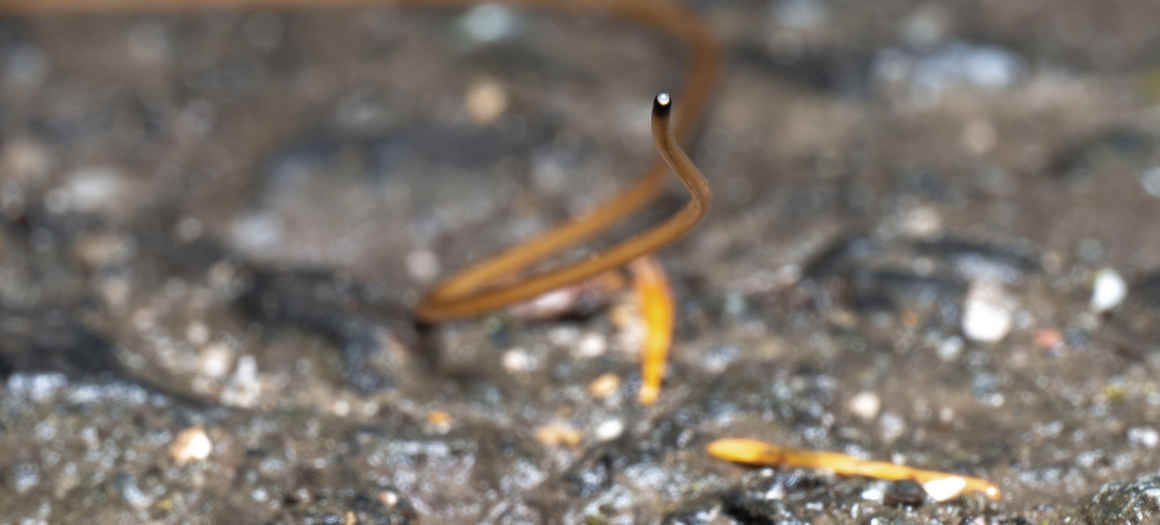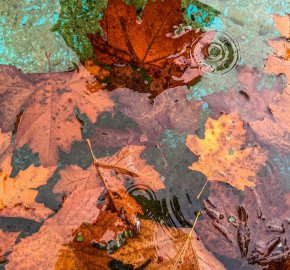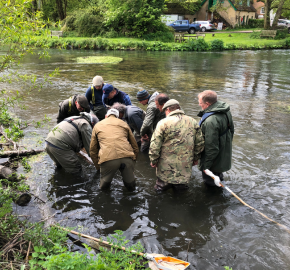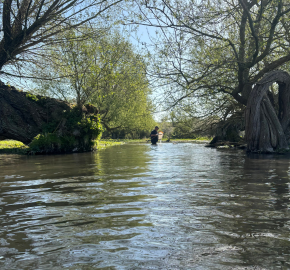Freshwater Frights: The Spookiest Invertebrates this Halloween

Parasites that control the minds of their hosts, demon shrimps that viciously kill the natives, cannibal larvae feeding on their own kind, fly maggots with vampire fangs, and phantom midges…our freshwaters are teeming with spooky yet fascinating invertebrates! Let’s dive into their eerie world.
Horsehair worms (Phylum Nematomorpha)
The text-book horror example, horsehair worms are a mysterious group of parasites that resemble long, brown spaghetti more than actual horse hairs. Adults are free-living and typically found in freshwater lakes, ponds, rivers and streams. They can reach lengths of up to 10 cm and widths between 0.5 to 3 mm.
Sometimes, several individuals form tightly coiled knots (especially during mating), earning them the nickname “Gordian worms”. This name refers to the Greek legend of the Gordian knot, which Alexander the Great, famously untied, fulfilling a prophecy that he would rule Asia.
If lacking a gut, respiratory, and circulatory system wasn’t strange enough, their life cycle is both bizarre and macabre. Adults lay strings of eggs on aquatic vegetation. When the eggs hatch, the larvae seek out a host to parasitise, typically crickets, cockroaches, grasshoppers and even diving beetles. Once inside the host’s body cavity, they absorb nutrients through their skin, growing and moulting until they fill the entire cavity. At this point, the worm manipulates the host’s behaviour, turning it into a kind of zombie. The infected insect is compelled to leap into water, against its natural instinct, where it drowns, allowing the adult worm to exit through the posterior end and return to its aquatic habitat. Remarkably, this behaviour can also be triggered by pouring water over a cricket or grasshopper, as the worm somehow detects the presence of water from within.
Adult horsehair worms do not feed but can survive for extended periods among vegetation. They have even been found in the snow in Pakistan and in karstic caves in China.

Image 01: Horsehair worm ©Ueli Zellweger
Demon shrimps (Dikerogammarus haemobaphes)
These invasive crustaceans earned the nickname “Demon shrimps” due to their aggressive behaviour.: Tthey often kill a wide range of prey (including other invertebrates and small fish) without consuming them, decimating entire populations. Not only do they compete with native species for resources, but they also feed on key decomposers such as the native shrimp (Gammarus pulex) and the water hog lice, disrupting the natural breakdown of organic matter in freshwaters.
Originating from the Ponto-Caspian region (around the Azov, Black and Caspian Seas), these little demons likely arrived in the United Kingdom as stowaways, clinging to ship hulls or hidden in ballast water. First recorded in the River Severn in 2012, they have since spread rapidly through rivers and canals across the country.
Their demoniac traits include fast reproduction, high egg output, rapid maturation, tolerance to high temperatures (up to 30°C), and the ability to survive in damp equipment for up to 14 days. Additionally, they carry a fungus (Cucumispora ornata) that might harm native shrimps and potentially affect their own feeding and movement (although further research is needed to understand these interactions).
To prevent their spread, it is essential to check, clean and dry any equipment used in freshwater environments.

Image 02: Demon Shrimp ©Dr Cyril Bennett
Cannibal midges (Diptera: Chironomidae)
Non-biting midges are among the most successful insects on Earth, with a global distribution that spans environments as extreme as the open ocean and Antarctica. Their life cycle includes several freshwater stages, from the egg to (typically) four larval instars (the growth stages of a larva between two successive molts in which it sheds its exoskeleton) and a pupal phase, before emerging as adults.
Under stressful conditions, such as overcrowding or lack of sediment and food (especially in laboratory settings), larvae of certain species (e.g., Chironomus riparius) have been observed turning on each other. Using their powerful mandibles to attack and kill fellow larvae. The survivors then consume the victims from back to front, often leaving only the head behind.

Image 03: Larva of Cannibal Midge ©Dr Luis Moliner Cachazo
Hunter fly larvae (Limnophora riparia)
These pale maggots are semiaquatic predators that live in mosses in waterfalls, lake outlets, spillways and splash zones of rivers and streams. To resist being swept away by the current, they anchor themselves using four posterior processes covered in recurved spines, which grip tightly to the surface.
Hunter fly larvae are carnivorous but not particularly mobile. They lie in wait among mosses or other submerged surfaces, ambushing soft-bodied prey with their long, vampire-like fangs. Their victims include oligochaetes, gammarids, black flies (their favourite), mosquito larvae, biting and non-biting midges, winter crane flies and drain flies.
When feeding, they behave like true vampires. First, they encircle the prey by twisting their front body segments and immobilise it with spines on the first segment. Once the prey is firmly secured, they release their posterior anchoring appendages and use them to further wrap around the victim. Then, they pierce the prey’s ‘neck’ or head with their fangs, injecting paralysing toxins and digestive enzymes that liquefy internal tissues for consumption.
These maggots are so ruthless that, in times of scarcity, they won’t hesitate to cannibalise their own kind.

Image 04: the fangs of a Hunter Fly Larvae ©Dr Rachel Walker, Barnes Common Charity
Phantom midge larvae (Chaoborus spp.)
Another group of midges with eerie aquatic larvae are the phantom midges. Their name comes from the dense, ‘menacing’ swarms that they form when emerging from the water, particularly dramatic in the African Great Lakes. They are also known as ‘glassworms’ due to their transparent bodies, which reveal internal structures including two air sacs. These sacs can be inflated or deflated to control buoyancy, allowing them to move vertically through the water column.
Like proper ghosts, phantom midge larvae rise near the surface at night to feed on phytoplankton. But unlike most insect larvae, they use their antennae to capture prey, modified into grasping appendages that give them a truly spooky appearance!
Cannibalism is also part of their repertoire. In laboratory experiments, young larvae have been observed eating others when crowded, while older larvae show a preference for consuming younger ones, regardless of other available food sources.

Image 05: Phantom midge larvae possibly engulfing a larva of a horsehair worm ©Dr Luis Moliner Cachazo
From the freaky to the fascinating, these species play a vital role in freshwater ecosystems
Despite their ghostly traits, all these creatures are harmless to humans. In fact, they play a vital role in freshwater ecosystems as a food source for fish and other invertebrates, and they serve as excellent indicators of water quality. Moreover, aside from the invasive demon shrimp, the native species described above help to regulate invertebrate populations. through predation and cannibalism.
For all these reasons, freshwater invertebrates are regularly monitored by our SmartRivers volunteers, who collect vital environmental data. We use this data to protect wild fish by challenging inadequate environmental protections and holding regulators accountable.
List of References
Canal & River Trust (2025) Killer and demon shrimp. Available here (accessed: 15/10/2025).
Eibl, J. and Copeland, R. (2005) Phantom Phenomenon – explanation. The Diptera Site. Available here (accessed: 15/10/2025).
Graham, H. (2014) An investigation into the impacts of a non-native Gammarid, Dikerogammarus haemobaphes, on the benthic macroinvertebrate community and ecosystem function of the River Cherwell. MSc. Dissertation. School of Geography, Earth and Environmental Sciences, University of Birmingham. Available here (accessed: 15/10/2025).
Hanelt, B., Thomas, F. and Schmidt-Rhaesa, A. (2005) Biology of the Phylum Nematomorpha. Advances in Parasitology, 59: 243-305. doi: https://doi.org/10.1016/S0065-308X(05)59004-3
Head, S. Nematomorphs or Horsehair worms. Wildlife Gardening Forum. Available here (accessed: 15/10/2025).
Jamal, Q., Riaz, M., Uddin, M. and Schmidt-Rhaesa, A. (2025) Gordius nixus sp. nov.: first report of a horsehair worm (Gordiida, Nematomorpha) from snow in Pakistan. Evolutionary Systematics, 9: 183-189. doi: https://doi.org/10.3897/evolsyst.9.153102
Merritt, R.W. and Wotton, R.S. (1988) The Life History and Behavior of Limnophora riparia (Diptera: Muscidae), a Predator of Larval Black Flies. Journal of the North American Benthological Society, 7(1): 1-12. doi: https://doi.org/10.2307/1467826
Strauss, T., Kulkarnib, D., Preussc, T.G., Hammers-Wirtz, M. (2016) The secret lives of cannibals: Modelling density-dependent processes that regulate population dynamics in Chaoborus crystallinus. Ecological Modelling, 321: 84–97. doi: http://dx.doi.org/10.1016/j.ecolmodel.2015.11.004
Welch, J. (2012) The superhero battling the killer shrimp in our waters. BBC News Online. Available here (accessed: 15/10/2025).




